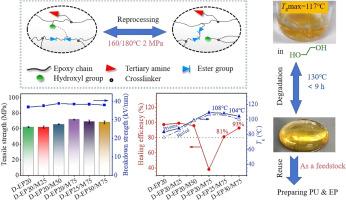High-performance insulating epoxy Vitrimers: Facile modification enables ultra-high healing efficiency and closed-loop recycling
IF 7.4
2区 化学
Q1 POLYMER SCIENCE
引用次数: 0
Abstract
To develop an insulating epoxy Vitrimer exhibiting synergistic enhancement of intrinsic performance alongside recyclability under mild conditions, this study fabricates a system via a facile approach involving dipropylamine modification and a blend hardener system composed of methyl hexahydrophthalic anhydride (MHHPA) and glutaric anhydride. The optimized D-EP30/M75 epoxy Vitrimer, containing 30 mol% dipropylamine modifier and 75 mol% MHHPA hardener, exhibits outstanding properties: an electrical breakdown strength of 38.01 kV/mm, tensile strength of 68.4 MPa, glass transition temperature (Tg) of 104℃, and 93 % tensile strength healing recovery.
Using ethylene glycol as a solvent at 130°C, all designed epoxy Vitrimers (2-mm-thick plates), including D-EP20/M100 with a Tg up to 117℃, are fully degraded within 9 h. The polyalcohols obtained via degradation (PAls) are suitable as feedstocks for epoxy resin and polyurethane preparation. This study establishes a simple and sustainable paradigm for high-performance insulating epoxy Vitrimers, integrating high healing efficiency and closed-loop recycling to address sustainability challenges, with significant promise for circular economy adoption.

高性能绝缘环氧树脂:简单的改性,实现超高的愈合效率和闭环回收
为了开发一种具有内在性能协同增强和温和条件下可回收性的绝缘环氧玻璃聚合物,本研究通过二丙胺改性和由甲基六氢邻苯二酸酐(MHHPA)和戊二酸酐组成的混合硬化剂体系的简单方法制备了一种体系。优化后的D-EP30/M75环氧玻璃体含有30 mol%的二丙胺改性剂和75 mol%的MHHPA硬化剂,具有优异的性能:电击穿强度为38.01 kV/mm,拉伸强度为68.4 MPa,玻璃化转变温度(Tg)为104℃,拉伸强度愈合回收率为93%。以乙二醇为溶剂,在130℃下,所有设计的环氧玻璃体(2mm厚板),包括Tg高达117℃的D-EP20/M100,在9 h内完全降解。通过降解获得的聚醇(PAls)适合作为环氧树脂和聚氨酯制备的原料。本研究为高性能绝缘环氧玻璃体建立了一个简单而可持续的范例,将高愈合效率和闭环回收结合起来,以解决可持续性挑战,并为循环经济的采用带来了重大希望。
本文章由计算机程序翻译,如有差异,请以英文原文为准。
求助全文
约1分钟内获得全文
求助全文
来源期刊

Polymer Degradation and Stability
化学-高分子科学
CiteScore
10.10
自引率
10.20%
发文量
325
审稿时长
23 days
期刊介绍:
Polymer Degradation and Stability deals with the degradation reactions and their control which are a major preoccupation of practitioners of the many and diverse aspects of modern polymer technology.
Deteriorative reactions occur during processing, when polymers are subjected to heat, oxygen and mechanical stress, and during the useful life of the materials when oxygen and sunlight are the most important degradative agencies. In more specialised applications, degradation may be induced by high energy radiation, ozone, atmospheric pollutants, mechanical stress, biological action, hydrolysis and many other influences. The mechanisms of these reactions and stabilisation processes must be understood if the technology and application of polymers are to continue to advance. The reporting of investigations of this kind is therefore a major function of this journal.
However there are also new developments in polymer technology in which degradation processes find positive applications. For example, photodegradable plastics are now available, the recycling of polymeric products will become increasingly important, degradation and combustion studies are involved in the definition of the fire hazards which are associated with polymeric materials and the microelectronics industry is vitally dependent upon polymer degradation in the manufacture of its circuitry. Polymer properties may also be improved by processes like curing and grafting, the chemistry of which can be closely related to that which causes physical deterioration in other circumstances.
 求助内容:
求助内容: 应助结果提醒方式:
应助结果提醒方式:


